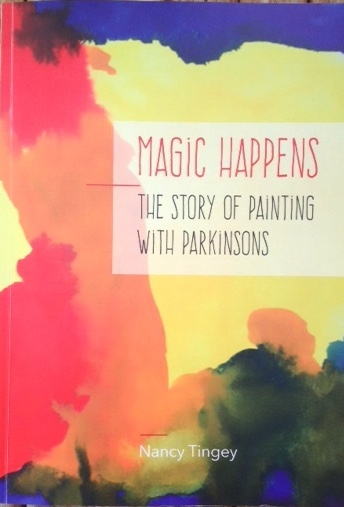 Artist and curator Nancy Tingey was the first person I interviewed for my history of the Churchill Trust, Inspiring Australians (2015) and it was a wonderful story to begin my research with. Nancy founded the group, Painting with Parkinsons in Canberra in 1994. Her husband Bob had been diagnosed with Parkinson’s a few years before when he was 46.
Artist and curator Nancy Tingey was the first person I interviewed for my history of the Churchill Trust, Inspiring Australians (2015) and it was a wonderful story to begin my research with. Nancy founded the group, Painting with Parkinsons in Canberra in 1994. Her husband Bob had been diagnosed with Parkinson’s a few years before when he was 46.
Nancy Tingey began the group she called Painting with Parkinsons ‘just [as] an idea for a fun thing to do’. Her beautifully produced book, Magic Happens, outlines the journey of Painting with Parkinsons, with insights of some class members, teachers and facilitators. Nancy Tingey’s own professional and personal journey gently threads its way through this powerful and moving book.
It is fascinating to read about the flowering of a simple, experimental idea and the beneficial, sometimes miraculous, changes wrought by the subsequent classes. Awarded a Churchill Fellowship in 1996, Nancy was able to travel to Europe and North America to expand her understanding of the therapeutic benefits of art for people with Parkinson’s. A synergy came about, where Nancy discovered new techniques and ideas in this area and the people overseas were in turn influenced by her ideas. Ultimately, Painting with Parkinsons developed into an internationally recognised role model.
In Magic Happens we learn that the condition of Parkinson’s begins with a diminishing of dopamine, the neurotransmitter that is vital for the smooth functioning of the central nervous system. The cause is not yet understood.
Creativity is good for the brain
Medication can supply dopamine, which calms down the nervous system so that neural impulses flow freely again. And as the author discovered, creative activity has a similar effect, as does meditation.
People in Nancy’s Painting with Parkinsons groups found that they breathed more easily when painting. One person said that she had ‘a lovely flowing feeling’ at the end of her fingertips while she painted. Another loved ‘the joy of starting something that I can complete without having to ask for help.’ (p. 77) Some comment on the humour and levity in the classes, which teacher John Pratt believes comes from a great feeling of trust.
‘When I am sketching I forget about Parkinson’s and it forgets about me,’ said participant Charles Armstrong.
Yoga, tai chi and meditation
Nancy met some Parkinson’s groups in England and elsewhere who were doing yoga, tai chi and meditation. She saw participants’ symptoms diminish or even disappear during an hour-long yoga session. This effect was usually temporary but it gave welcome respite and proved a wonderful thing for people to be able to anticipate each week.
One person in Margate had been doing yoga every day for five years. Her doctor said that he could find no increase in her symptoms over that time. In Toronto a tai chi teacher reported similar results.
When Nancy returned from her Churchill Fellowship she remodelled her classes to enrich them with the latest overseas breakthroughs and techniques. Her program became so successful that it influenced the establishment of other Parkinson’s groups in Australia and overseas.
Unexpected synergy
Nancy began inviting musicians to play while the people in her classes painted. Tremors disappeared and rigidity relaxed as they were more easily able to get into a state of ‘flow’. The music informed the paintings and in an unexpected synergy the musicians saw how their playing ‘had not only sparked creative response in the visual work but had looped back and enhanced their own performance.’ (p. 108)
A sense of identity
‘Through the arts,’ maintains the author, ‘we maintain our sense of identity by being able to articulate our experience of the world … This sense of identity is part of our humanity. … The arts allow us to speak even when we have difficulty conveying what we want to say or cannot articulate verbally. They are essential tools of communication.’ (p. 114)
As art therapist Sally Schofield writes, art therapy improves health by ‘leading the mind to different levels where the visual prevails over the logical, and connecting the individual with their creativity, something very important for someone who has to adapt to set limitations and a new situation as a result of an illness like Parkinson’s.’ (p. 149)
Nancy Tingey has been awarded a 2019 OAM for services to community health. Her gorgeously illustrated, informative and fascinating book can be bought for $30 from selected bookshops and from the website of Painting with Parkinsons at https://paintingwithparkinsons.org.au/
Magic Happens will be launched in Canberra on Saturday 16 February at 4.00 p.m. at Muse, East Hotel, Canberra Avenue, Kingston. (By invitation only.)

Leave a Reply